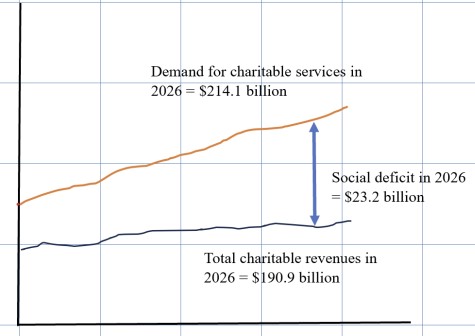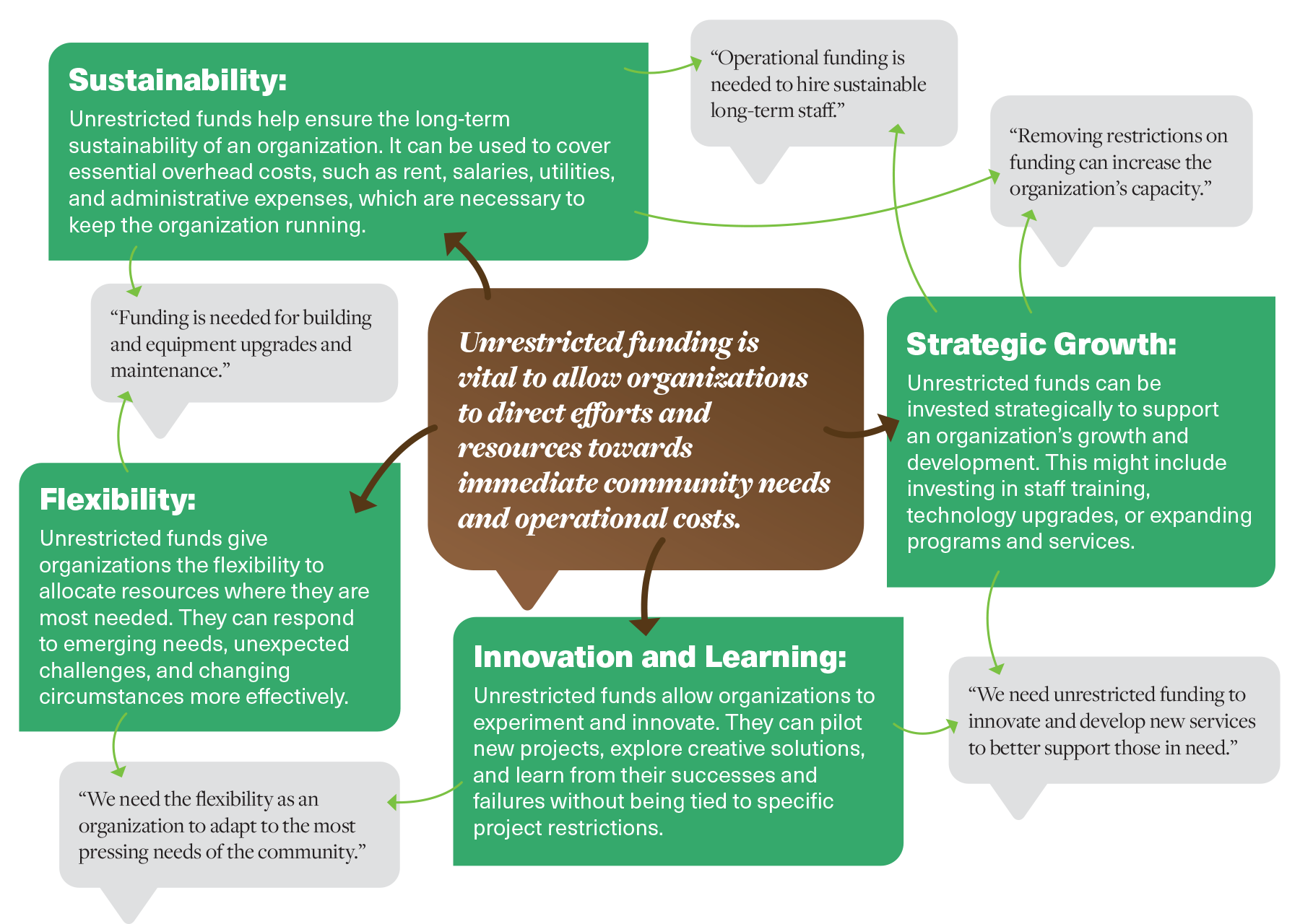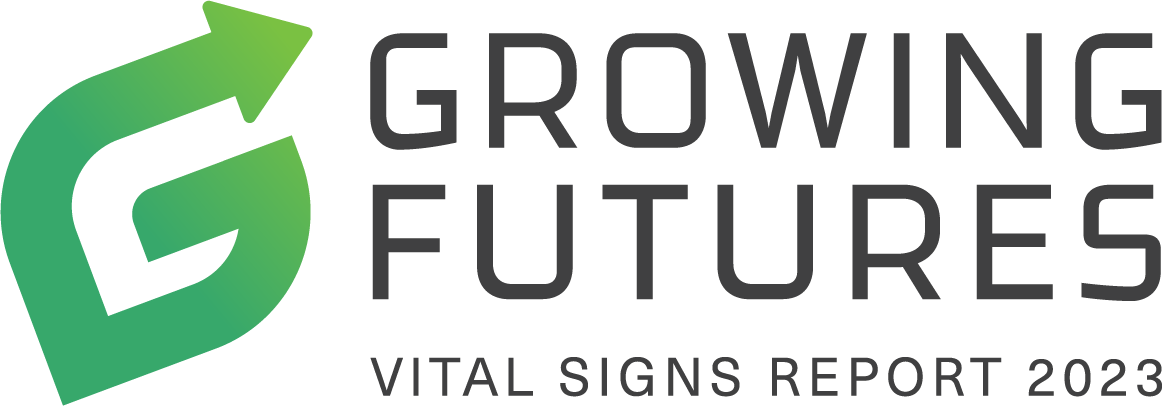Additional Findings: Community Funding Gaps
16% of Survey Responses
The Key Takeaway:
Unrestricted funding is vital to allow organizations to direct efforts and resources towards immediate community needs and operational costs.
Truth and Reconciliation Calls to Action Addressed:
46.iii UNDRIP
United Nations SDGs Addressed:
4.1, 4.2, 4.4, 4.a, 9.1, 9.2, 17.16, 17.17
What are community organizations saying?
- Funding needed to hire non-profit staff because relying on volunteers is difficult.
- Funding needed to support newcomer/immigrant/refugee families with children.
- Funding needed for youth with intellectual disabilities.
- Funding needed to engage with Indigenous Knowledge Keeper.
- Funding needed for new programs (i.e., addiction’s support, pet-friendly shelter spaces).
- Funding needed for respite care program.
- Funding needed for technology for the blind.
- Funding needed for educational programs.
- Funding needed to support core needs.
- Non-program unrestricted funding is needed.
We have been here for over 35 years. We listen well and we know what the community needs, but when funding is limited to specific projects, it limits our capacity to focus on core challenges and core needs of our community.”
- Ann Perry, Executive Director of The Circle Project
What is driving these funding gaps?
Post-pandemic effects:
At the onset of the COVID-19 pandemic, charities and non-profit organizations were the ‘first responders’ to address community needs, pivoting nearly overnight to meet new service demands.⁹ Available resources – programs or otherwise – were pooled to address immediate community priorities. The pandemic also derailed the usual fundraising activities of many charities, leaving them with little, if any, private donations. This is because donors were also experiencing financial strain from sudden job losses and reduced disposable incomes. As organizations are returning to more normal operations, they may be finding themselves with limited resources to address existing community needs.
Program-based vs. operational funding requirements:
Governments or other institutional funders often designate their funding to specific projects and outcome-based programs. From the perspective of community organizations, such funding approaches create barriers for organizations to respond to emergent community needs in a timely manner and may even lead to long-term financial instability. Access to core funding would create opportunities to cover essential costs (i.e., grant writing, fundraising, etc.) for the purpose of generating new funds for operations.¹⁰
Possible funding misalignment:
Evidence suggests that funding often goes to ‘popular’ causes.¹¹ For example, in the United Kingdom, mental health, addictions, support of vulnerable children, and domestic violence fall under unpopular causes. While this type of evidence has not been collected in Canada, practitioners and field experts question if where funding is going aligns with where support is needed most. The size of a charity can also play a role in attracting funding whereby people prefer to give to larger more established organizations.¹² However, it is often small charities
(those with assets less than $100K) that tend to be aware of pressing community needs and can pivot quickly to address them.
The key implication of the existing funding gaps is a rapidly rising social deficit. Social deficit, as defined by Imagine Canada (2018), is a phenomenon “where there are not enough services to meet increased need.”¹³ We are currently at a time where we are witnessing increased demand for charitable and nonprofit services, but slower economic growth resulting from the effects of the COVID-19 pandemic. If these circumstances persist, researchers project that the social deficit will amount to $23.2 billion by 2026 (Figure 10).¹⁴ Charities and nonprofit organizations are calling on governments and institutional funders to adopt unrestricted funding practices.
Social Deficit Projection
For 2026

Figure 10: Social Deficit Projection for 2026
Source: Author’s graph based on Emmet (2016) “Charities, Sustainable Funding and Smart Growth.”
In 2022, 86% of total granted funds distributed through the South Saskatchewan Community Foundation supported unrestricted operational needs for charities.

Rethinking Support through Unrestricted Funding:

Vital Reflections:
The following Vital Reflections are questions you can ask yourself to ponder ways to get involved and address community funding gaps. These are intended to be a starting point to get you thinking of how you can help within your own individual capacity:
- How can I identify local charities that are facing funding gaps and need operational support?
- Can I use my skills, such as grant writing or financial planning, to assist charities in securing long-term operational funding?
- Are there potential corporate or philanthropic partnerships I can facilitate to provide sustained financial support?
- What innovative fundraising strategies or revenue-generating activities can I suggest to charities?
- What advocacy efforts can I participate in to promote policies that facilitate stable and unrestricted operational funding for charities?
Help make a difference. Support your community today.
References
9 Vital COVID-19 Focus. 2021. “Through COVID-19 and Beyond: Charities and the Heart of Our Communities”. South Saskatchewan Community Foundation.
10 Core Funding Brief. 2022. Imagine Canada.
11 Body, Allison and Beth Breeze. 2016. “What are ‘unpopular causes’ and how they can achieve fundraising success?”, International Journal of Voluntary Sector Marketing, 21: pp. 57-70.
12 Payne. 2012. “Changing Landscapes for Charities in Canada”. SPP Papers 5(34). University of Calgary.
13 Imagine Canada. 2018. “Canada’s Emerging Social Deficit”.
14 Emmet, Brian. 2016. “Charities, Sustainable Funding and Smart Growth”. Imagine Canada.
